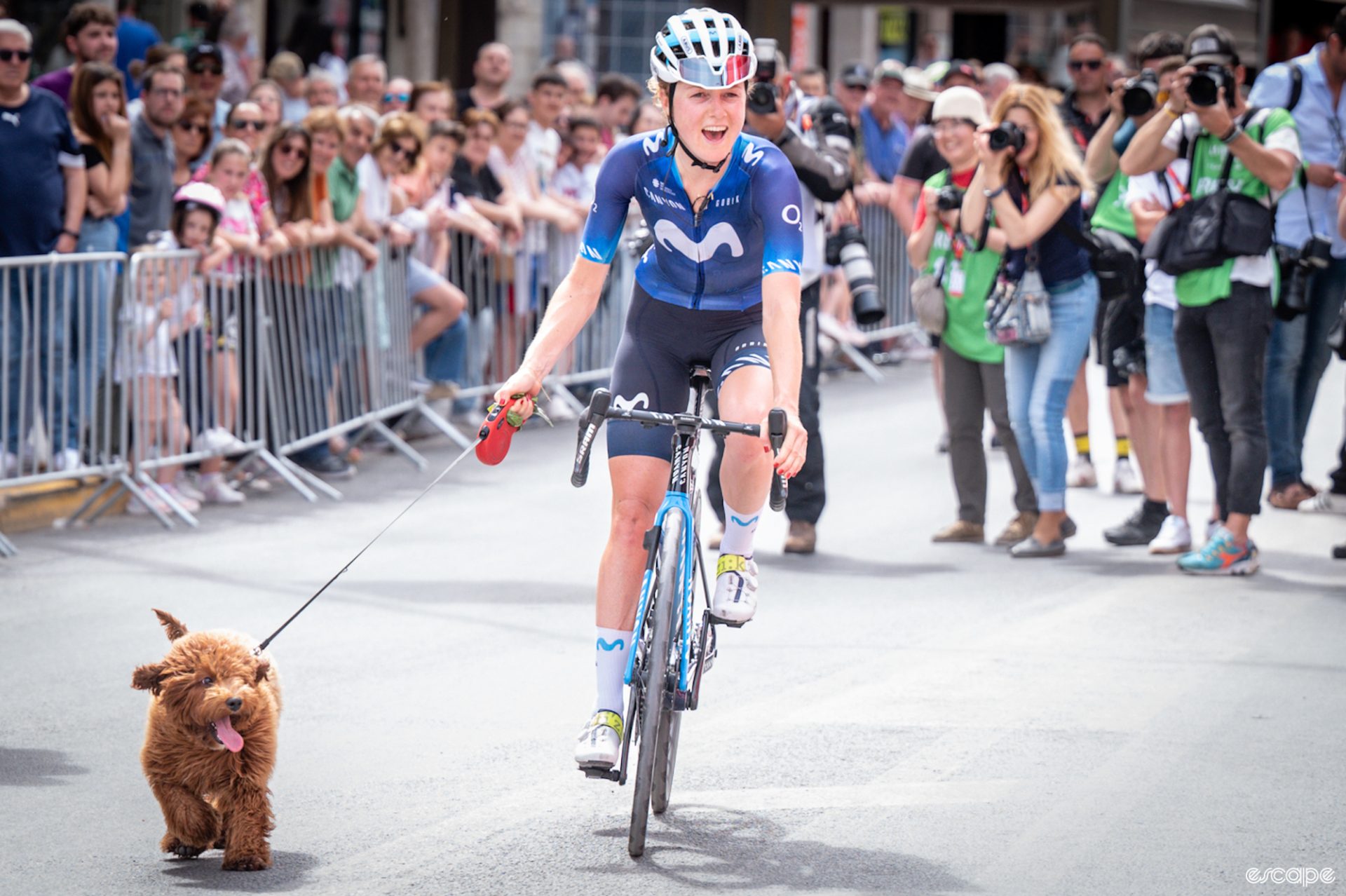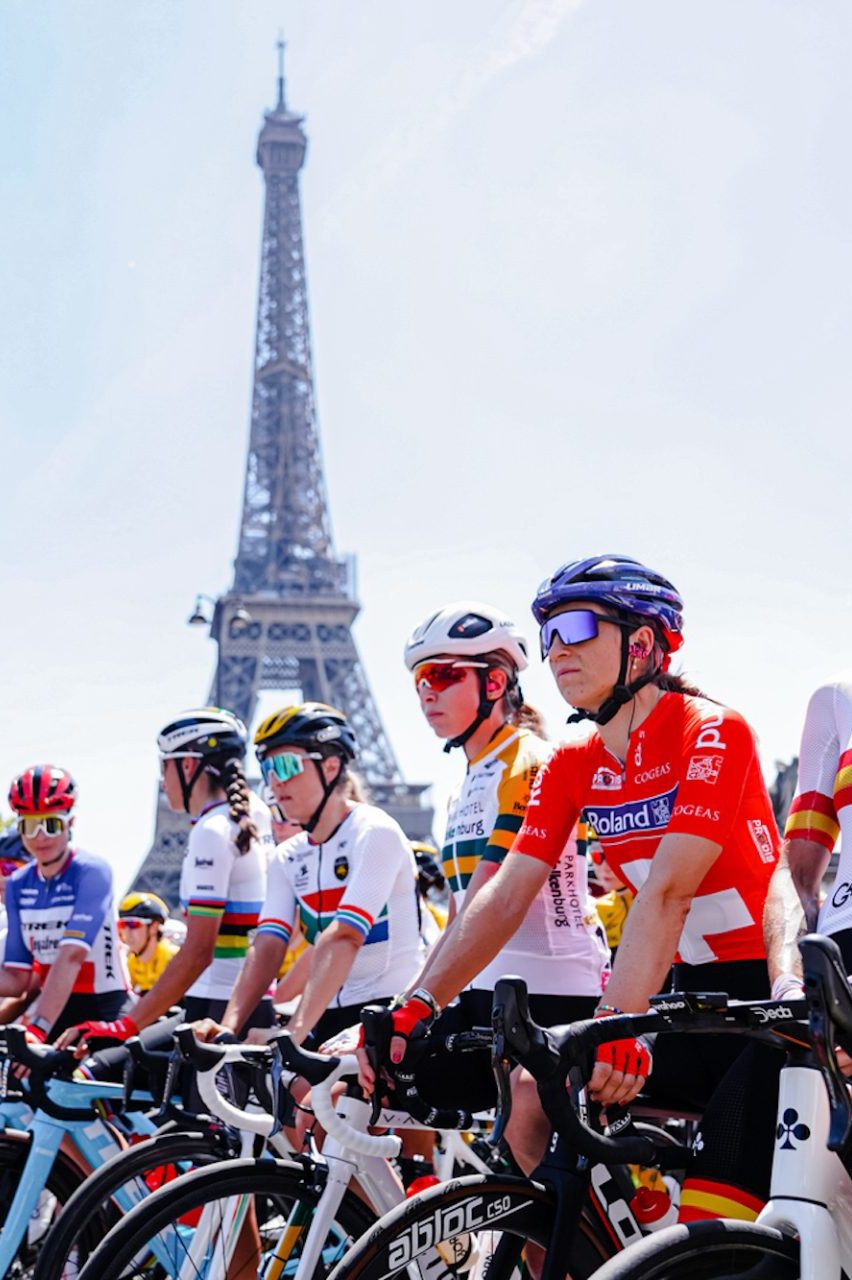Thanks again for opening this edition of the Wheel Talk Newsletter! I’ve been a bit shocked by the reception, I really can’t stress how great you all are (you, who are reading this). In case you didn’t know, you can also receive this newsletter as an email, straight to your inbox!
The 2023 season is only just over but we are already looking forward to 2024. Last week it was announced that 16 teams put their hands up for 15 Women’s WorldTour licenses and, as it turns out, the overhyped and overly stressed relegation battle is not a battle at all.
Thanks mostly to EF Education-TIBCO-SVB folding with their license and Jayco-AlUla and Liv Racing-TeqFind joining forces, Israel-Premier Tech-Roland, Uno-X, and Human Powered Health didn’t actually need to scramble for points. Ceratizit-WNT and AG Insurance-Soudal Quick-Step will likely join the WT, as is only right. Ceratizit-WNT in particular has fielded strong teams for many years now on the women’s side and AG Insurance-Soudal Quick-Step, led by Ashleigh Moolman Pasio, was pretty darn good this year too.
The three teams playing leapfrog at the bottom of the standings – Israel-Premier Tech-Roland, Uno-X and Human Powered Health – spent a lot of the season sending their riders to lesser races in search of points. Thanks to Daria Pikulik securing two WorldTour wins for the American Team, HPH finished the joint 2022/2023 seasons in 16th, just ahead of Uno-X. In theory, they were both out of the top 15 teams, however, as luck would have it, they will likely remain in the top tier. Good thing too, as HPH just announced the addition of Georgia Bronzini as its new DS and the signing of Ruth Winder, who retired in 2021 following the Tokyo Olympic Games. Winder will return to the peloton with a different American team than the one she spent the best years of her career on, but will bring some much-needed experience to HPH.
When the dust settled, Israel-Premier Tech-Roland (which is moving forward as just Roland) actually finished ahead of AG Insurance-Soudal Quick-Step and Liv Racing-TeqFind. IPT didn’t have any massive wins but a few riders who consistently finished in the top 10 of WT races, like Tamara Dronova and Claire Steels (who will be off to Movistar next year on a four year deal).
The real surprise in the 2024 WT hopefuls was the Spanish Laboral Kutxa Fundacion Euskadi team. Ranked 25th in the UCI standings but 33rd in the joint relegation standings, the team applied already in 2022 and was denied, and hasn’t exactly stepped it up to prove it deserved that license in 2024. The whole thing is a mystery, but it’s highly unlikely the team will be handed the right to call itself a top team in women’s cycling. The team’s top rider is Italian Nadia Quagliotto, and its best results in 2023 were all at Spanish national-level events (Trofeu de Ciclisme Femeni Classica de l’arròs, GP Villaquilambre, etc).
Who will get the licenses remains to be seen, it’s now in the hands of the UCI, but we will let you know as soon as that decision is made. Stay tuned to EscapeCollective.com.
?️ Wheel Talk Podcast ?️
This week I had the absolute pleasure of chatting with one of my favorite women in sports journalism, Rebecca Charlton. We chat about riding through pregnancy, missing the inaugural Tour de France Femmes avec Zwift, getting to experience the race firsthand this year, and so much more. You’ve heard her voice on the podcast before but I thought a longer chat with her would be fun, so I hope you all enjoy it!
? Let’s discuss ?
Olympic selection.
With the season over so is the period riders can gather points toward their nation’s Olympic allotment. The way spots are divvied up is super weird but I will try to explain it …
So. The International Olympic Committee gives each sport a maximum number of athletes and it is up to the sport’s governing body to figure out how to divvy up athlete representation across all the disciplines. When it comes to cycling, the UCI must spread that out between mountain bike (cross-country), track cycling’s various endurance and sprint events (both team and individual), road racing (road race and individual time trial), and BMX (freestyle and racing).
Sometimes there’s a situation, like Chloe Dygert in the Tokyo Games, where an athlete competes in both track and road, essentially freeing one spot to be filled by another athlete (in this case it was Amber Neben in the ITT; she did not race the road race). In the case of the men’s New Zealand team, they had a track rider also start the men’s road race in the 2016 Rio de Janeiro Games only to exit the race shortly after the start, so they could have an extra spot on the track. This is also why a lot of times the same athletes compete in the ITT and road race.
Prior to 2024, the men’s road race contained 130 competitors while the women’s road race only started with 67, but the IOC announced in March of 2023 that the 2024 Games would be the first to achieve full gender equality. So, to even out the playing field, the UCI took numbers away from the men’s road race and added them to the women’s.
So 90 men and 90 women will line up next year in Paris for the road races. (88 places for men and 88 for women, plus two extra riders each for France as the host country). The time trial will also be equal with 35 riders of each gender lining up, but all out of those 88 each. If you can math, you will notice 17 spots went missing from the road disciplines (130 + 67 = 197; 90 + 90 = 180). Where did they go? Distributed out to other disciplines, mostly. Six of the spots went to BMX freestyle, for example.
This is an interesting situation, because while the women should definitely have a larger peloton than 67, the men need to have a larger peloton than 90. The men will race 273 km and with only 90 riders that is … going to make for some weird racing. By contrast, the women will race 158 km. The distances are not equal, nor should they be, unless it’s cutting the men’s race down. You don’t really want the racing to be super weird when they are fighting for a gold medal at the Olympics; isn’t it supposed to be the peak of sport?
It seems like a better solution would have been to increase the number of athletes at the Games so more women could attend, rather than taking from the men’s side to give to the women. The men’s race will definitely suffer from the changes.
I should note the sport-wide athlete caps are because the IOC is trying to balance the demands of 10,500 athletes from 32 different sports, with new events being added … logic that unfortunately gets in the way of my disgruntled attitude.
One of the biggest benefits of the change is the number of spots handed to each nation. In Tokyo the top five teams had five riders each for the road race, the next three had three, and the next five had two (one being Japan for hosting). Then there were 26 nations with only one rider. In Paris, there’s more parity among the 55 competing nations: the top five teams will have four riders, with three spots handed to the next five teams, two to teams ranked 11-20, and the final 35 nations are on their own with only one spot. Marlen Reusser, who raced solo in Tokyo, will have two teammates thanks to her help driving Switzerland to sixth in the standings. The additional support for nations like Switzerland and Poland will make for better racing.
For one race of the year, everything we know about cycling goes out the window anyway. Sometimes it ends in an epic finale (Rio de Janeiro) sometimes it’s pure chaos (Tokyo), but that’s part of the magic. The battle to make it to the Olympics is a two-year (sometimes longer) talking point amongst the sport. A lot can change and does, and the fact that only a handful are tapped to compete on the Olympic stage is part of the reason it’s such a big deal.
Heading into the 2024 Games there will be more women on the start line (a good thing) but once again the means to get to that starting number, is missing some critical thinking on the part of the UCI and IOC. Like I said, the men’s race will suffer, and that’s not the answer to equality.
NATIONS with 4 riders: Netherlands, Italy, Belgium, Great Britain, France
NATIONS with 3 riders: Switzerland, Poland, Australia, Germany, United States
NATIONS with 2 riders: Denmark, Canada, Austria, New Zealand, Spain, South Africa, Uzbekistan, Norway, Slovenia, Cuba
NATIONS with one rider: China, Colombia, Russia? (I will not get into this in this episode …), Ukraine, Czech Republic, Finland, Sweden, Thailand, Japan, Rwanda, Hong Kong, South Korea, Ireland, Luxembourg, Brazil, Chile, Belarus? (again ?♀️), Mauritius, Kazakhstan, Serbia, Slovakia, Israel, Lithuania, Namibia, Portugal, Algeria, Hungary, United Arab Emirates, Vietnam, Malaysia, Burkina Faso, Costa Rica, Nigeria, Latvia, Mexico
? The joys of social media ?
Yes.
More of this.
Kasia Niewiadoma raced her first Gravel event post-Worlds, and won, doing the rainbow jersey justice. It looks good on her, right? Like it belongs. I’m sure I’m not the only one hoping she can score the road title next.
?️ A picture worth a couple words ?️
You know when dogs look like their owners? Well, exhibit A:

I dare you not to smile when you look at this 10/10 photo, snapped at a stage start of La Vuelta Femenina, of Floortje Mackaij and her fluffy dog Bella. Bella, who celebrated her birthday over the weekend, joined the Mackaij family to follow Floortje’s Tour of Spain in May. She can often be found at race starts, bringing a skip to the steps of Mackaij and her teammates.
? Your weekly dose of Taylor Swift ?
The order of Taylor Swift’s re-records was a hot topic for fans of the singer as soon as she announced her plans, perhaps even before, as fans were debating which would be first and which would be last. She started, fittingly, with Fearless (Taylor’s Version), followed by Red (Taylor’s Version), and then recently Speak Now (Taylor’s Version).
From the very beginning of her career, Swift would drop clues in her social media posts, the booklets that came with CDs, and other spots for fans to find and decipher. At a certain point fans started to catch on and Swift’s “Easter eggs” started to get … unhinged. In the leadup to her release of Fearless (Taylor’s Version), she dropped a vault, a literal vault, where fans could unscramble letters to figure out the titles of her upcoming vault tracks.
At this point every single thing she does is picked apart by fans, from the socks she’s wearing to her Instagram captions (not a lot going on at the moment).
Only one music video was released with Speak Now TV, and the clues weren’t exactly subtle that we were headed straight for a new 1989 era, Taylor’s Version.
? Until next time! ?
Thanks so much (again) for reading this week’s Wheel Talk Newsletter.
If you’re not already signed up I would ask you politely to consider becoming a member of Escape Collective! We’ve got some cool stuff going on over on the website, but we also have a pretty remarkable community of members you can find on our Discord. Is Discord too overwhelming for you? Same. But if you just pick the channels you’re interested in, it’s like being on a group chat with a bunch of buds.
Find out more about becoming a member here.
And I’ll be back next week!
What did you think of this story?


